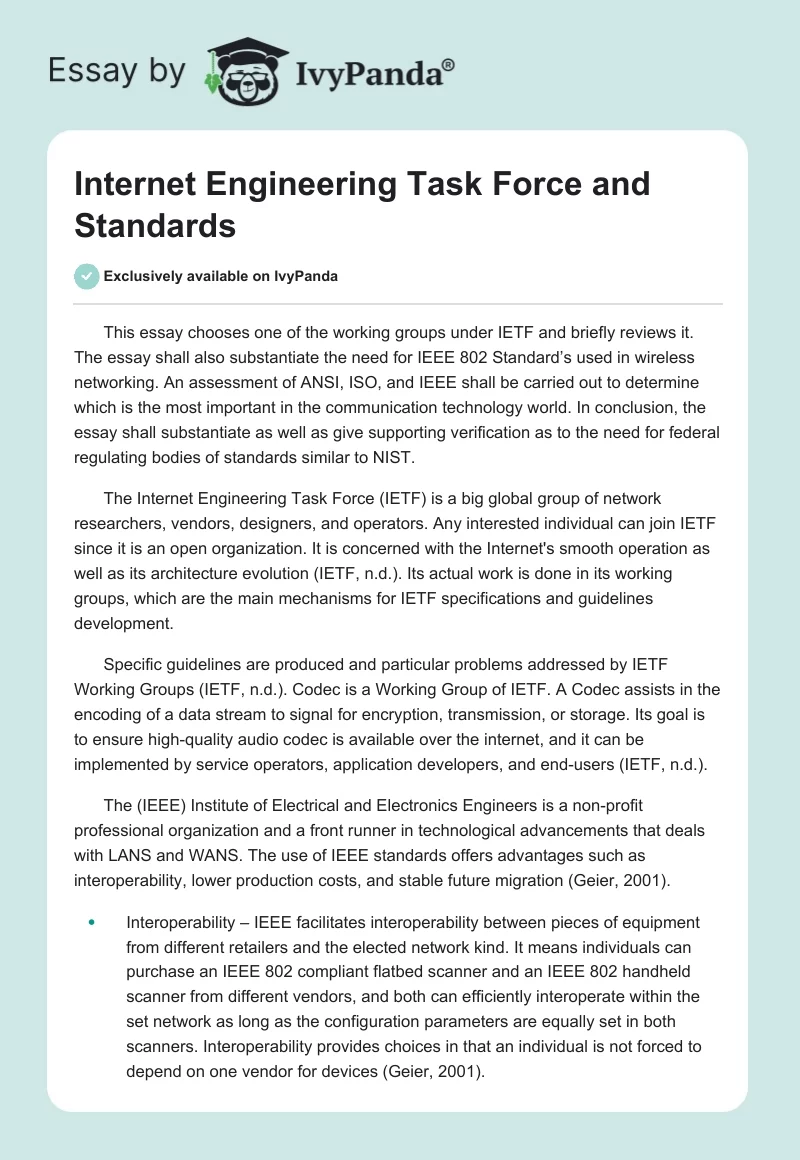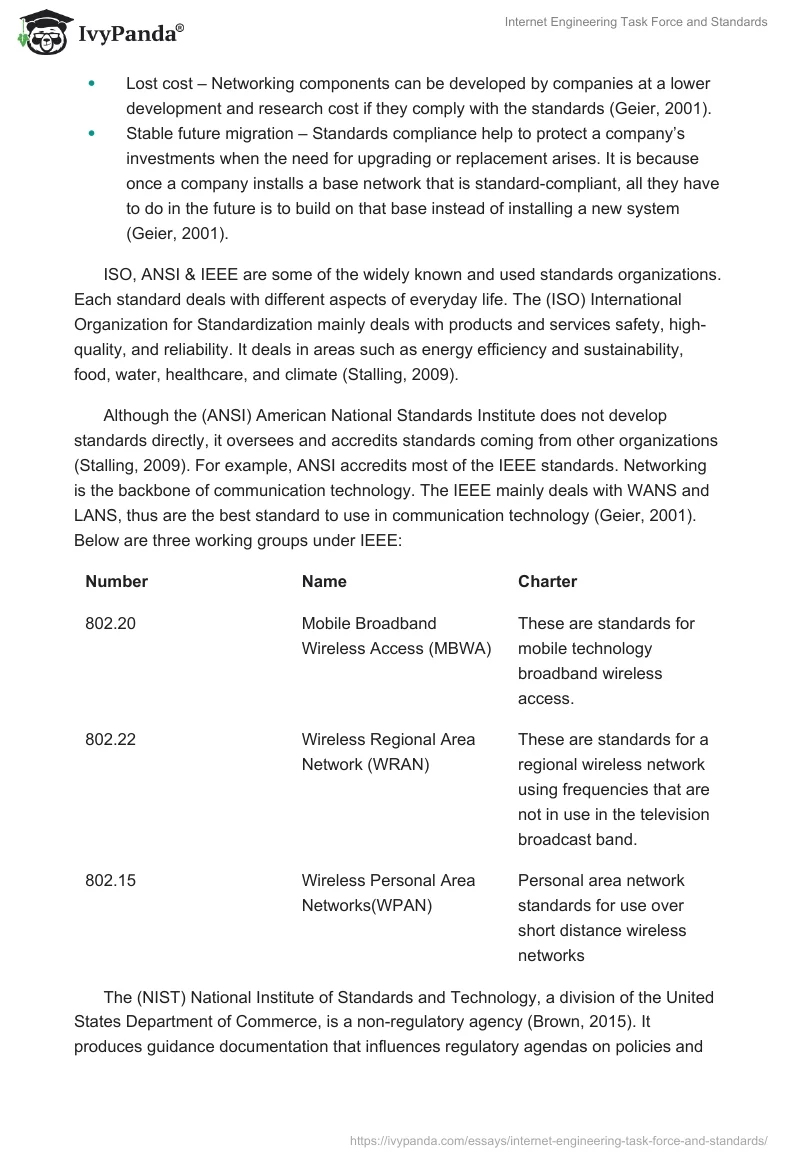This essay chooses one of the working groups under IETF and briefly reviews it. The essay shall also substantiate the need for IEEE 802 Standard’s used in wireless networking. An assessment of ANSI, ISO, and IEEE shall be carried out to determine which is the most important in the communication technology world. In conclusion, the essay shall substantiate as well as give supporting verification as to the need for federal regulating bodies of standards similar to NIST.
The Internet Engineering Task Force (IETF) is a big global group of network researchers, vendors, designers, and operators. Any interested individual can join IETF since it is an open organization. It is concerned with the Internet’s smooth operation as well as its architecture evolution (IETF, n.d.). Its actual work is done in its working groups, which are the main mechanisms for IETF specifications and guidelines development.
Specific guidelines are produced and particular problems addressed by IETF Working Groups (IETF, n.d.). Codec is a Working Group of IETF. A Codec assists in the encoding of a data stream to signal for encryption, transmission, or storage. Its goal is to ensure high-quality audio codec is available over the internet, and it can be implemented by service operators, application developers, and end-users (IETF, n.d.).
The (IEEE) Institute of Electrical and Electronics Engineers is a non-profit professional organization and a front runner in technological advancements that deals with LANS and WANS. The use of IEEE standards offers advantages such as interoperability, lower production costs, and stable future migration (Geier, 2001).
- Interoperability – IEEE facilitates interoperability between pieces of equipment from different retailers and the elected network kind. It means individuals can purchase an IEEE 802 compliant flatbed scanner and an IEEE 802 handheld scanner from different vendors, and both can efficiently interoperate within the set network as long as the configuration parameters are equally set in both scanners. Interoperability provides choices in that an individual is not forced to depend on one vendor for devices (Geier, 2001).
- Lost cost – Networking components can be developed by companies at a lower development and research cost if they comply with the standards (Geier, 2001).
- Stable future migration – Standards compliance help to protect a company’s investments when the need for upgrading or replacement arises. It is because once a company installs a base network that is standard-compliant, all they have to do in the future is to build on that base instead of installing a new system (Geier, 2001).
ISO, ANSI & IEEE are some of the widely known and used standards organizations. Each standard deals with different aspects of everyday life. The (ISO) International Organization for Standardization mainly deals with products and services safety, high-quality, and reliability. It deals in areas such as energy efficiency and sustainability, food, water, healthcare, and climate (Stalling, 2009).
Although the (ANSI) American National Standards Institute does not develop standards directly, it oversees and accredits standards coming from other organizations (Stalling, 2009). For example, ANSI accredits most of the IEEE standards. Networking is the backbone of communication technology. The IEEE mainly deals with WANS and LANS, thus are the best standard to use in communication technology (Geier, 2001). Below are three working groups under IEEE:
The (NIST) National Institute of Standards and Technology, a division of the United States Department of Commerce, is a non-regulatory agency (Brown, 2015). It produces guidance documentation that influences regulatory agendas on policies and operations. NIST’s purpose is to motivate private industrial organizations to work together so as to find better solutions to technological obstacles (Brown, 2015).
NIST’s task is to increase the value of life and improve economic security by advancing technology, standards, and measurement science. NIST hopes to promote United States industry competitiveness and innovation. NIST’s functions include support of commerce by trade facilitation and encouraging voluntary agreement based standards to be established by the cooperation of both private and international efforts (Brown, 2015).
There is a need for a federal regulating body of standards such as NIST because it encourages the industry to find solutions to problems affecting it as a whole. If an operation or policy is under NIST, its longevity, and widespread acceptance in wireless network implementation is assured (Brown, 2015). It also offers more flexibility in the selection and use of equipment, since the vendors are required to produce devices that conform to the standards operation policies and regulations.
NIST ensures there is only one standard for one thing, which means there is less conflict in a case where multiple standards, for one thing, are presented. NIST ensures that there is no technology freezing due to the duration it takes to develop, review, compromise, and disseminate other technology techniques (Stallings, 2009). NIST also ensures there will be a vast and fair market for equipment or software since they shall be interoperable with other equipment (Brown, 2015).
References
Brown L. M. (2015). NIST Plays Increasingly Prominent Roles in Privacy Policy. Wiley Rein LLP. Web.
Geier, J. (2016). Overview of the IEEE 802.11 Standard. Informit. Web.
Internet Engineering Task Force. (n.d). About the IETF. Web.
Stallings, W. (2009). Business data communications. Upper Saddle River, N.J.: Pearson/Prentice Hall.


